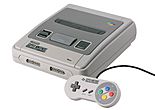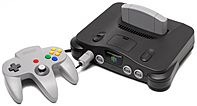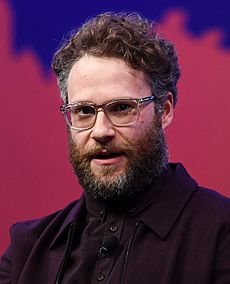Donkey Kong facts for kids
Quick facts for kids Donkey Kong |
|
|---|---|

Logo since 2010
|
|
| Creator | Shigeru Miyamoto |
| Original work | Donkey Kong (1981) |
| Owner | Nintendo |
| Films and television | |
| Films | The Super Mario Bros. Movie (2023) |
| Audio | |
| Original music | "Aquatic Ambience" "DK Rap" |
| Miscellaneous | |
| Theme park attractions | Super Nintendo World |
| Related franchise(s) | Mario |
Donkey Kong is a video game series and media franchise created by the Japanese game designer Shigeru Miyamoto for Nintendo. The franchise follows the adventures of Donkey Kong, a large, powerful gorilla. Donkey Kong series include the original arcade game trilogy by Nintendo R&D1; the Donkey Kong Country series by Rare and Retro Studios; and the Mario vs. Donkey Kong series by Nintendo Software Technology. Various studios have developed spin-offs in other genres such as racing and rhythm. The franchise also incorporates animation, printed media, a theme park, and merchandise.
Miyamoto designed the original 1981 Donkey Kong to salvage unsold arcade cabinets following the failure of Radar Scope (1980). It was a major success and was followed by the sequels Donkey Kong Jr. (1982) and Donkey Kong 3 (1983). The franchise went on a hiatus as Nintendo shifted its focus to the spin-off Mario franchise. Rare's 1994 reboot, the Super Nintendo Entertainment System (SNES) game Donkey Kong Country, reestablished Donkey Kong as a major Nintendo franchise. Rare developed Donkey Kong games for the SNES, Game Boy, and Nintendo 64 until they were acquired by Microsoft in 2002; subsequent games have been developed by Nintendo, Retro Studios, Namco and Paon. No major Donkey Kong games have been released since Donkey Kong Country: Tropical Freeze in 2014.
The main Donkey Kong games are platformers in which the player must reach the end of a level. Donkey Kong was initially the antagonist, but became the protagonist starting with Country. The original games featured a small cast of characters, including Donkey Kong, Mario, Pauline, and Donkey Kong Jr. Rare's games expanded the cast with friendly Kongs, such as Diddy, Cranky, Funky and Dixie, and the Kremlings, an army of antagonistic crocodiles led by Donkey Kong's nemesis King K. Rool. Mario, the protagonist of the 1981 game, became Nintendo's mascot and the star of the Mario franchise, and Donkey Kong characters appear in Mario games such as Mario Kart, Mario Party, and Mario Tennis. Donkey Kong has also crossed over with other franchises in games such as Mario & Sonic and Super Smash Bros.
Donkey Kong is one of Nintendo's bestselling franchises, with more than 65 million units sold by 2021. The original game was Nintendo's first major international success and established it as a prominent force in the video game industry. The franchise has pioneered or popularized concepts such as in-game storytelling and pre-rendered graphics, inspired other games (including clones), and influenced popular culture.
History
1981–1982: Conception and first game

In the late 1970s, the Japanese company Nintendo shifted its focus from producing toys and playing cards to arcade games. This followed the 1973 oil crisis having increased the cost of manufacturing toys and the success of Taito's Space Invaders (1978). In 1980, Nintendo released Radar Scope, a Space Invaders-style shoot 'em up. It was a commercial failure and put the newly established subsidiary Nintendo of America in a financial crisis. Its founder, Minoru Arakawa, asked his father in-law, the Nintendo CEO Hiroshi Yamauchi, to provide a new game that could salvage the unsold Radar Scope cabinets. Most of Nintendo's top developers were preoccupied, so the task went to Shigeru Miyamoto, a first-time game designer.
Supervised by Gunpei Yokoi, Miyamoto settled on a love triangle with the characters Bluto, Popeye, and Olive Oyl from the Popeye franchise, but Nintendo was unable to obtain the license. Bluto evolved into a gorilla, an animal Miyamoto said was "nothing too evil or repulsive". He named the character Donkey Kong—donkey to convey stubborn and kong to imply gorilla. Popeye became Mario, the new protagonist, while Olive Oyl became Pauline, the damsel in distress. Miyamoto named "Beauty and the Beast" and the 1933 film King Kong as influences. As he lacked programming expertise, he consulted technicians on whether his concepts were possible. Four programmers from Ikegami Tsushinki spent three months turning Miyamoto's concept into a finished game.
Donkey Kong was one of the earliest platform games, following Mario as he ascends a construction site to rescue Pauline from Donkey Kong. It was released in July 1981 and became Nintendo's first major international success. The windfall of $280 million rescued Nintendo of America from its financial crisis and established it as a prominent brand in America. Donkey Kong achieved further success in 1982, when Nintendo released a Game & Watch version and licensed it to Coleco for ports to home consoles. It grossed $4.4 billion across various formats, making it one of the highest-grossing games of all time. In 1982, Universal City Studios filed a lawsuit alleging Donkey Kong violated its trademark of King Kong. The lawsuit failed when Nintendo's lawyer, Howard Lincoln, discovered that Universal had won a lawsuit years prior by declaring that King Kong was actually in the public domain. The victory cemented Nintendo as a major force in the video game industry.
1982–1994: Sequels and first hiatus
Miyamoto and his team had designed game mechanics and levels for Donkey Kong that could not be included, so they used them as the basis for a sequel. Miyamoto wanted to make Donkey Kong the protagonist, but the sprite was too big to easily maneuver, so he created a new character, Donkey Kong Jr. The team still wanted Donkey Kong on top of the screen, so they conceived a plot in which Mario had caged him and Donkey Kong Jr. had to save him. To develop Donkey Kong Jr., Nintendo reverse-engineered Ikegami's Donkey Kong code, making it the first game that Nintendo developed without outside help. Following Donkey Kong Jr.'s release in 1982, Ikegami sued Nintendo for copyright infringement. In 1990, the Tokyo High Court ruled in favor of Ikegami, and the companies reached a settlement.
Donkey Kong 3, released in 1983, features shooter gameplay that departs from its predecessors. Instead of Mario, the player controls Stanley, an exterminator from the Game & Watch game Green House (1982) who must fend off Donkey Kong and a swarm of bees. Donkey Kong 3 was unsuccessful, as was an edutainment game for the Nintendo Entertainment System (NES), Donkey Kong Jr. Math (1983). The franchise went on an extended hiatus, while the spin-off Mario franchise found success on the NES, cementing Mario as Nintendo's mascot. The 1987 Official Nintendo Player's Guide advertised a Donkey Kong revival for the NES, The Return of Donkey Kong, which was never released. In 1994, the franchise's first original game in more than 10 years, Donkey Kong (often referred to as Donkey Kong '94), was released for the Game Boy. It begins as a remake of the 1981 game before introducing over 100 puzzle-platforming levels that incorporate elements from Donkey Kong Jr. and Super Mario Bros. 2 (1988).
1994–1996: Rare and Donkey Kong Country
Around 1992, Rare, a British studio founded by the brothers Tim and Chris Stamper, purchased Silicon Graphics, Inc. (SGI) Challenge workstations with Alias rendering software to render 3D models. At the time, Nintendo was embroiled in a console war with Sega, whose Genesis competed with the Super Nintendo Entertainment System (SNES). Nintendo wanted a game to compete with Sega's Aladdin (1993), which featured graphics by Disney animators, when Lincoln learned of Rare's SGI experiments during a trip to Europe. After impressing Nintendo with a demonstration, Tim Stamper—inspired by Mortal Kombat's use of digitized footage in place of hand-drawn art—suggested developing a platform game that used pre-rendered 3D graphics.
Nintendo granted the Stampers permission to use the Donkey Kong intellectual property; some sources indicate that the Stampers obtained the license after Nintendo offered them its catalog of characters and they chose Donkey Kong, though the designer Gregg Mayles recalled that it was Nintendo that requested a Donkey Kong game. Nintendo figured licensing Donkey Kong posed minimal risk due to the franchise's dormancy. Rare's reboot, Donkey Kong Country, featured side-scrolling gameplay that Mayles based on the Super Mario series. It was the first Donkey Kong game neither directed nor produced by Miyamoto, though he provided support and contributed design ideas.
Donkey Kong Country was one of the first games for a mainstream home video game console to use pre-rendered graphics, achieved through a compression technique that allowed Rare to convert 3D models into SNES sprites with little loss of detail. Because Donkey Kong did not have much of an established universe, Rare was free to expand it, introducing Donkey Kong's sidekick Diddy Kong (who replaced Donkey Kong Jr.) and the antagonistic Kremlings. After 18 months of development, Donkey Kong Country was released in November 1994 to acclaim, with critics hailing its visuals as groundbreaking. It was a major success, selling 9.3 million copies and becoming the third-bestselling SNES game. It reestablished Donkey Kong as a major Nintendo franchise and heralded Donkey Kong's transition from villain to hero. Following the success, Nintendo purchased a large minority stake in Rare.
Rare began developing concepts for a Donkey Kong Country sequel during production, and Nintendo green-lit the project immediately after the success. Donkey Kong Country 2: Diddy's Kong Quest, released in 1995, features Diddy rescuing a kidnapped Donkey Kong and introduces Diddy's girlfriend Dixie Kong. Diddy's Kong Quest was designed to be less linear and more challenging, with a theme reflecting Gregg Mayles' fascination with pirates. Like its predecessor, Diddy's Kong Quest was a major critical and commercial success, and is the sixth-bestselling SNES game. Following Diddy's Kong Quest, the Donkey Kong Country team split in two, with one half working on Donkey Kong Country 3: Dixie Kong's Double Trouble! (1996). Featuring Dixie and a new character, Kiddy Kong, as protagonists, the Dixie Kong's Double Trouble! team sought to incorporate 3D-esque gameplay and Zelda-inspired role-playing elements. Although it was released late in the SNES's lifespan and after the launch of the Nintendo 64, Dixie Kong's Double Trouble! sold well.
1995–2002: Franchise expansion
Separate Rare teams developed the Game Boy games Donkey Kong Land (1995), Donkey Kong Land 2 (1996), and Donkey Kong Land III (1997), which condensed the Country series' gameplay for the handheld game console. Rare's Game Boy programmer, Paul Machacek, chose to develop Land as an original game rather than as a port of Country after convincing Tim Stamper it would be a better use of resources. A port of Country was eventually released for the Game Boy Color in 2000. Rare also developed a tech demo for a Virtual Boy Donkey Kong game, but it never progressed due to the system's commercial failure.
The first Donkey Kong game for the Nintendo 64, Diddy Kong Racing, was released as Nintendo's major 1997 Christmas shopping season product. Rare originally developed it as a sequel to its NES game R.C. Pro-Am (1988), but added Diddy Kong to increase its marketability. Diddy Kong Racing received favorable reviews and sold 4.5 million copies. Two of Diddy Kong Racing's playable characters, Banjo the Bear and Conker the Squirrel, would go on to star in the Banjo-Kazooie and Conker franchises.
Rare began working on Donkey Kong 64, the first Donkey Kong game to feature 3D gameplay, in 1997. They conceived it as a linear game similar to the Country series, but switched to a more open-ended design using the game engine from their 1998 game Banjo-Kazooie after 18 months. Donkey Kong 64 was released in November 1999, accompanied by a US$22 million marketing campaign. It was Nintendo's bestselling game during the 1999 Christmas season and received positive reviews, though critics felt it did not match the revolutionary impact of Donkey Kong Country.
At E3 2001, Nintendo and Rare announced three Donkey Kong projects: the GameCube game Donkey Kong Racing and the Game Boy Advance (GBA) games Donkey Kong Coconut Crackers and Diddy Kong Pilot. However, development costs were increasing and Nintendo opted not to acquire Rare. In September 2002, Microsoft acquired Rare for $375 million, making Rare a first-party developer for Xbox. Nintendo retained the rights to Donkey Kong under the terms of the acquisition. Donkey Kong Racing was canceled, and Rare reworked Donkey Kong Coconut Crackers and Diddy Kong Pilot into It's Mr. Pants (2004) and Banjo-Pilot (2005).
2002–2010: After Rare
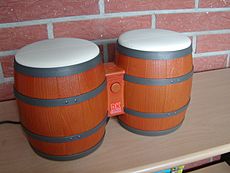
After Microsoft acquired Rare, Nintendo relegated Donkey Kong to spin-offs and guest appearances in other franchises, such as Mario Kart, Mario Party, and Super Smash Bros. In 2003, Nintendo and Namco released Donkey Konga (2003), a spin-off rhythm game. It was designed for the DK Bongos, a GameCube peripheral that resembles bongo drums. Nintendo of America executive Reggie Fils-Aimé opposed releasing Donkey Konga, concerned it would damage the Donkey Kong brand, but it sold well and received positive reviews. It was followed by Donkey Konga 2 (2004) and the Japan exclusive Donkey Konga 3 (2005).
Donkey Kong Jungle Beat, the first main Donkey Kong game since Donkey Kong 64, was released for the GameCube in 2004. It returned to the Donkey Kong Country style of platforming, controlled using the DK Bongos. It was directed by Yoshiaki Koizumi as the debut project of Nintendo EAD Tokyo. Koizumi sought to create an accessible game with a simple control scheme to contrast with more complex contemporary games. It received positive reviews, but was a commercial disappointment. A Wii version, featuring revised Wii Remote and Nunchuk controls, was released in 2008 as part of the New Play Control! line. A racing game that used the DK Bongos, Donkey Kong Barrel Blast, was developed by Paon for the GameCube, but was moved to the Wii with support for the peripheral dropped. It was released in 2007 to negative reviews, with criticism for its controls.
Despite the acquisition, Rare continued to develop games for Nintendo's handheld consoles since Microsoft did not have a competing handheld. It developed ports of the Country games for the GBA and Diddy Kong Racing for the Nintendo DS with additional content, released between 2003 and 2007. Meanwhile, Paon also developed DK: King of Swing (2005) for the GBA and DK: Jungle Climber (2007) for the DS, which blend Country elements with gameplay inspired by Clu Clu Land (1984). Mario vs. Donkey Kong, a spin-off series that acts as a spiritual successor to the Game Boy Donkey Kong, began with a 2004 GBA game and continued with several sequels. In contrast to other post-Country games, Mario vs. Donkey Kong restored Donkey Kong's villainous role.
2010–present: Retro Studios and second hiatus
In 2008, Miyamoto expressed interest in a Donkey Kong Country revival. Producer Kensuke Tanabe suggested that Retro Studios, which had developed the Metroid Prime series, would be suitable. With Donkey Kong Country Returns, Retro sought to retain classic Country elements while refining them to create a new experience and introducing new game mechanics such as surface-clinging and simultaneous multiplayer. Returns, the first original Country game since Dixie Kong's Double Trouble!, was released for the Wii in 2010. It sold 4.21 million copies in under a month and received positive reviews, with critics considering it a return to form for the franchise. Monster Games developed a Nintendo 3DS version in 2013.
Retro developed a sequel, Donkey Kong Country: Tropical Freeze, for the Wii U. The Wii U's greater processing power allowed for visual elements that the team had been unable to accomplish on the Wii, such as lighting and translucency effects and dynamic camera movement. Tropical Freeze was released in 2014 to favorable reviews, but it sold poorly in comparison to Returns. It achieved greater success when it was ported to the Nintendo Switch in 2018, outselling the Wii U version within a week of release. Following Tropical Freeze, the Donkey Kong franchise went on another hiatus, outside of the Mario vs. Donkey Kong games Tipping Stars (2015) and Mini Mario & Friends: Amiibo Challenge (2016) for the Wii U and 3DS.
Nintendo Life reported in 2021 that Nintendo Entertainment Planning & Development was working on a Switch Donkey Kong game. Nintendo released a remake of the first Mario vs. Donkey Kong with new levels and cooperative gameplay for the Switch in February 2024.
Story and characters
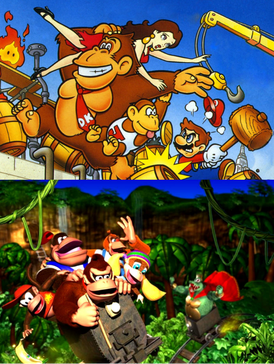
The original Donkey Kong features three characters: Donkey Kong, a large, antagonistic gorilla; Mario, the overall-wearing protagonist; and Pauline, Mario's girlfriend. Donkey Kong follows Mario as he ascends a construction site to rescue Pauline from Donkey Kong, his escaped pet ape. In the sequel, Donkey Kong Jr., Mario imprisons Donkey Kong in a cage. The game introduces Donkey Kong's son, the diaper-wearing Donkey Kong Jr. Mario, Pauline, Donkey Kong, and Jr. return in the 1994 Game Boy Donkey Kong, in which Mario again must rescue Pauline from the Kongs. The Game Boy game was the first Donkey Kong game to depict Donkey Kong wearing a red necktie bearing his initials, "DK".
Beginning with Donkey Kong Country, Donkey Kong's role shifted from the antagonist to the protagonist. Rare's Kevin Bayliss redesigned him; alongside the red tie from the Game Boy game, he was given what GamesRadar+ described as "menacing, sunken eyes and [a] beak-like muzzle", and Bayliss designed him as blocky and muscular to make animating him easier. Rare's games characterize him as the descendant of the Donkey Kong character from the arcade games, who appears as the elderly Cranky Kong. Cranky Kong provides scathing, fourth wall-breaking humor in which he unfavorably compares current games to older ones like the original Donkey Kong. Donkey Kong Jr. was retired, and Nintendo's stance on whether Rare's Donkey Kong is a grown-up Donkey Kong Jr. or a separate character has been inconsistent.
Rare's games moved the franchise's primary setting from a city to Donkey Kong Island, an idyllic isle. Because Donkey Kong did not have much of an established universe, Rare was free to expand it with new characters. Donkey Kong Country introduced Diddy Kong, Donkey Kong's sidekick and nephew. Diddy's design was based on a spider monkey; he was created as a redesign of Donkey Kong Jr. but retooled into a separate character at Nintendo's request. Other supporting Kong characters that Rare introduced include Funky Kong, a surfer; Candy Kong, Donkey Kong's girlfriend; Dixie Kong, Diddy's girlfriend; Kiddy, a large toddler; Tiny Kong, Dixie's sister; and Lanky Kong.
The franchise's main antagonist is King K. Rool, an anthropomorphic reptilian introduced in Donkey Kong Country. K. Rool leads the Kremlings, an army of crocodiles who seek to steal Donkey Kong's hoard of bananas. Polygon summarized K. Rool as an archetypal game villain who "often wears disguises and invents strange gadgets for his elaborately evil schemes", such as dressing as a pirate captain in Donkey Kong Country 2. Other villains include the Tiki Tak Tribe, a race of floating masks that play music to hypnotize animals into stealing the banana hoard, and the Snowmads, Viking invaders who summon a dragon to take over Donkey Kong Island.
Mario, the protagonist of the 1981 game, went on to headline the Mario franchise. Although the franchises largely remain separate, they take place in the same fictional universe, and Donkey Kong and other Donkey Kong characters frequently appear as playable characters in Mario spin-offs such as Mario Kart, Mario Party, and Mario Tennis. Two Rare characters, Banjo the Bear and Conker the Squirrel, were introduced in Diddy Kong Racing ahead of starring in their own games, Banjo-Kazooie and Conker's Bad Fur Day (2001).
Gameplay
Original series
Donkey Kong and Donkey Kong Jr. are early examples of the platform game genre. In both games, the player must guide the playable character (Mario in the first game, Donkey Kong Jr. in the second) to scale four levels while avoiding obstacles. The player jumps to dodge incoming obstacles (such as barrels) or cross gaps and climbs ladders or vines to reach the top of the level. In the first game, Mario can destroy obstacles by obtaining a hammer power-up, while in the second, Donkey Kong Jr. can do so by knocking pieces of fruit down from vines. Points are awarded for dodging or destroying obstacles, collecting items, and completing stages quickly. The player begins each game with three lives, which they lose if they touch an obstacle or fall from a distance.
Donkey Kong 3 departs from this gameplay: it is a shooter game in which the player controls Stanley, an exterminator who must prevent Donkey Kong from stirring up insects in his greenhouse. The player fires bug spray at Donkey Kong and enemy insects that attempt to steal Stanley's flowers. They complete levels by spraying Donkey Kong enough to force him to the top of the screen or by killing all the insects.
The 1994 Game Boy game begins with the four stages from the original Donkey Kong, but after completing the fourth, the player is presented with over 100 additional stages that introduce puzzle-platform gameplay in which Mario must scout each level within a time limit to locate a key. Mario can pick up and throw objects and enemies, similar to Super Mario Bros. 2, and perform acrobatics to reach otherwise inaccessible areas of the levels. This gameplay would serve as the basis for Mario vs. Donkey Kong, which introduces stages in which Mario must guide six Mini-Mario toys to a toy box while protecting them from hazards. Mario vs. Donkey Kong's sequels make guiding the Mini-Mario toys the focus, with each stage requiring the player to do so with touchscreen controls. This gameplay has been frequently compared to the strategy video game Lemmings (1991).
Donkey Kong Country
The Donkey Kong Country series features platforming gameplay in which players complete side-scrolling levels to progress, reminiscent of Nintendo's Super Mario series. The player begins in a world map that tracks their progress and provides access to the themed worlds and their levels. They traverse the environment, jump between platforms, and avoid enemy and inanimate obstacles. Each world ends with a boss fight with a large enemy. The Country series is known for its high difficulty level and emphasis on momentum, requiring players to react to oncoming obstacles quickly to maintain flow.
Players control one of the various playable Kongs, depending on the game: Donkey Kong, Diddy Kong, Dixie Kong, Kiddy Kong, Cranky Kong, and Funky Kong. The Rare games each feature two protagonists, with one protagonist carrying over to the sequel while another is introduced, while both Retro Studios games star Donkey Kong. Players primarily control one Kong, with the second increasing their health. In the Rare games, the player can switch between characters if they are both on the screen. In the Retro Studios games, other characters ride on Donkey Kong's back to provide special abilities; for instance, Diddy's jetpack allows him to temporarily hover.
Country's distinctive game mechanics include blasting out of cannons resembling barrels, vehicle sequences with minecarts and barrel-themed rockets, levels in which the characters and foreground environments appear as silhouettes, and swinging ropes. Barrels return from the original series and can be used as weapons or broken to uncover power-ups. One variant, DK Barrels, releases a partner Kong when thrown. Each level contains collectibles such as bananas, letters that spell out K–O–N–G, balloons, and puzzle pieces. These items can be found within the main level or by discovering hidden bonus stages, where they are earned via completing a challenge.
In certain levels, the player can free an animal that provides the Kongs with special abilities, similar to the Super Mario series' Yoshi. Recurring animal friends include Rambi, a rhino that can charge into enemies and find hidden entrances; Enguarde, a swordfish that can defeat enemies underwater; and Squawks, a parrot who carries the Kongs or assists in finding collectibles. Outside the main gameplay, the Rare games' world map contains areas where players can converse with non-player characters, such as Cranky, who provide advice, collectibles, and save points. The Retro Studios games replace these with shops run by Cranky in Returns and Funky in Tropical Freeze where the player can purchase items like power-ups and lives.
Other games
Some games without the Country branding contain similar gameplay. The Donkey Kong Land trilogy condenses the SNES Country gameplay for the Game Boy, with different level design that accounts for the system's low-quality display. Donkey Kong 64 blends Country elements with "collect-a-thon" gameplay reminiscent of Super Mario 64 (1996) and Banjo-Kazooie (1998), while Jungle Beat's score attack emphasis challenges players to complete levels with as many points as possible. DK: King of Swing and DK: Jungle Climber are aesthetically similar to the Country games, but require players to use the shoulder buttons to grab and climb pegboards to reach the end of a level.
Diddy Kong Racing and Donkey Kong Barrel Blast are kart racing games that play similarly to the Mario Kart series, though Diddy Kong Racing features an adventure mode with boss fights and Barrel Blast has the player shake the Wii Remote and Nunchuk alternatively to accelerate. The Donkey Konga trilogy was developed by the Taiko no Tatsujin developers and features the same gameplay: the player must hit scrolling notes to the beat of the music with accurate timing, with stylized notes corresponding to different buttons. Players build combos by hitting two or more notes; the combo ends when they miss a beat.
Other media
Crossovers
Donkey Kong is represented in every game in Nintendo's Super Smash Bros. series of crossover fighting games. Donkey Kong debuted in the original Super Smash Bros. (1999) as the only heavyweight fighter, with slow but powerful attacks. Diddy Kong was added as a playable fighter in Super Smash Bros. Brawl (2008), while King K. Rool was added in Super Smash Bros. Ultimate (2018). Smash games also feature Donkey Kong stages and music.
Donkey Kong appears in Mario & Sonic, an Olympic Games-themed crossover between Mario and Sega's Sonic the Hedgehog franchise, as a playable character; in the Wii version of Punch-Out!! (2009) as the final boss; and in Mario + Rabbids Kingdom Battle (2017), a crossover between Mario and Ubisoft's Raving Rabbids franchise, as the protagonist of an expansion pack. Activision's toys-to-life game Skylanders: SuperChargers (2015) includes Donkey Kong as a playable character in the versions released on Nintendo platforms.
Animated series
A Donkey Kong cartoon aired as part of CBS's hour-long Saturday Supercade programming block in 1983. The cartoon follows Mario and Pauline as they attempt to capture Donkey Kong after he escapes from a circus. Game Informer described the series as "abysmal... filled with bad puns and ridiculous situations". Soupy Sales voiced Donkey Kong, while Peter Cullen and Frank Welker (who later garnered recognition for voicing Optimus Prime and Megatron in the Transformers franchise) voiced Mario and Donkey Kong Jr. Donkey Kong was also a recurring character in Captain N: The Game Master, a DIC Entertainment series that ran on NBC for 34 episodes between 1989 and 1991.
Donkey Kong Country, a television series produced by the French-Canadian company Medialab Technology, ran for 40 episodes between 1997 and 1999, bridging the gap between Dixie Kong's Double Trouble and Donkey Kong 64. Reflecting the games' pre-rendered 3D graphics, Donkey Kong Country was produced using computer animation, accomplished with motion capture technology. The series adopts a sitcom approach and follows Donkey Kong as he attempts to protect a magical artifact, the Crystal Coconut, from King K. Rool. Donkey Kong Country was produced with little input from Nintendo, and was the final Western series that Nintendo licensed before it shifted to producing and importing anime. The series was popular in France and Japan, though less so in the United States.
Printed media
The first issue of Blip, a short-lived American comic book published by Marvel Comics in 1983, features a story in which a foolish news reporter attempts to interview Mario during the events of the original Donkey Kong. The story characterizes Donkey Kong as the result of a failed experiment to breed construction-worker gorillas. Blip marked Mario's first appearance in a comic book, years before Valiant Comics' Nintendo Comics System series in the 1990s. The British comics publisher Fleetway Publications published a promotional Donkey Kong Country comic in the UK in 1995, while Michael Teitelbaum wrote children's book adaptations of Donkey Kong Country, Donkey Kong Land and Donkey Kong Country 2.
Film
Elements from the Donkey Kong franchise feature prominently in The Super Mario Bros. Movie (2023), an animated film produced by Nintendo, Illumination, and Universal Pictures. Mario (Chris Pratt) and Princess Peach (Anya Taylor-Joy) seek the Kongs' help to stop Bowser (Jack Black) from invading the Mushroom Kingdom. Seth Rogen and Fred Armisen voice Donkey Kong and Cranky Kong, while other Kongs make cameo appearances and the "DK Rap" plays during Donkey Kong's introduction. Donkey Kong was redesigned for the first time since Donkey Kong Country, combining elements of Rare's design and his original arcade-era design. The Super Mario Bros. Movie received mixed reviews, and Rogen received criticism for voicing Donkey Kong in his regular speaking voice. The film earned over $1 billion, making it the highest-grossing film based on a video game.
In November 2021, prior to The Super Mario Bros. Movie's release, reports emerged that Illumination was developing a Donkey Kong film with Rogen set to reprise his role. In April 2023, Rogen said he saw "a lot of opportunity" in the prospect. Eurogamer wrote that Diddy and Dixie's brief cameo in The Super Mario Bros. Movie was obvious setup for a Donkey Kong film.
Theme park
In September 2021, Nintendo and Universal Destinations & Experiences announced a Donkey Kong-themed expansion of the Super Nintendo World themed area at Universal Studios Japan. The area, Donkey Kong Country, is set to open in 2024 and will expand the size of Super Nintendo World by 70%. It was designed with consultation from Miyamoto and will include a roller coaster, Donkey Kong's Crazy Cart, based on the Tiki Tong boss fight from Donkey Kong Country Returns. The area will also feature a K–O–N–G letter collection game and offer Donkey Kong merchandise and food.
Merchandise
Donkey Kong merchandise includes clothing, toys such as plushes and Amiibo figures, breakfast cereal and soundtrack albums. The Lego Group began producing Donkey Kong Lego construction toys in 2023 as a subseries within its Lego Super Mario product line. The initial four sets, based on the Donkey Kong Country games, were released in August 2023.
See also
 In Spanish: Donkey Kong (serie) para niños
In Spanish: Donkey Kong (serie) para niños



